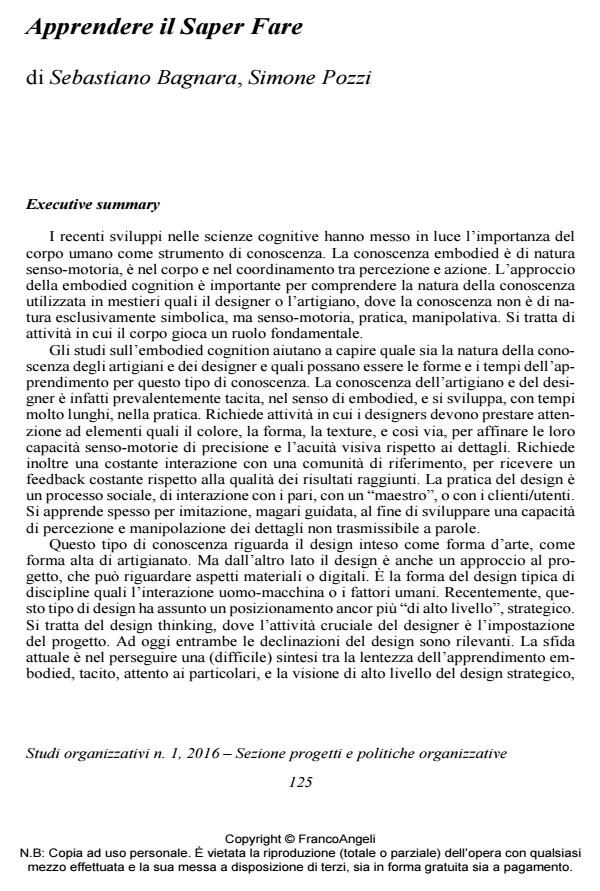Apprendere il Saper Fare
Journal title STUDI ORGANIZZATIVI
Author/s Sebastiano Bagnara, Simone Pozzi
Publishing Year 2016 Issue 2016/1 Language Italian
Pages 14 P. 125-138 File size 164 KB
DOI 10.3280/SO2016-001006
DOI is like a bar code for intellectual property: to have more infomation
click here
Below, you can see the article first page
If you want to buy this article in PDF format, you can do it, following the instructions to buy download credits

FrancoAngeli is member of Publishers International Linking Association, Inc (PILA), a not-for-profit association which run the CrossRef service enabling links to and from online scholarly content.
In this paper "Learning How to Design: the Role of Embodied Cognition" we present the contribution of embodied cognition to design. The embodied cognition approach seeks to understand the role played by our body in cognition, showing the ways in which body characteristics affect cognitive activities. This approach brings important insights about the nature of craftsmen and designers’ knowledge, which is of a sensory-motor nature, related to practical actions. To learn and to master this type of knowledge, designers need to engage in practical activities, characterised by long and slow learning processes. Designers need to pay attention to elements like colours, shape, texture, and other minute details. They need to develop capabilities to work on these details, improving their perception skills. This practice has a social dimension, too. It requires constant interaction and feedback from the designers’ community, or from customers. This form of knowledge is typical of the conception of "design as craft". However, nowadays design is also "strategic design", "design thinking", where design is primarily seen as the activity of shaping a project, tracing its scope and boundaries. One of the hardest challenges of the design discipline today is keeping in balance these two conceptions: the slow pace of craft with the long-term vision of strategic design, the attention to details with the strategic overview.
Keywords: Organization, design, embodied cognition, design thinking, interaction design, craftsmanship.
- Cooper, A., Reimann, R., Cronin, D. (2007), About Face 3. The Essentials of Interaction Design, Indianapolis, Wiley Publishing.
- Davenport, T.H. (2005), Thinking for a living, Boston, Harvard Business Press.
- Bagnara, S., Papeschi, F., Parlangeli, O., Pravettoni, G. (2007), “Oblio organizzativo”, Studi Organizzativi, 99: 157-174.
- Bagnara, S., Pozzi, S. (2011), “Il concetto di interfaccia”, in Di Nocera, F. (Ed.), Manuale di Ergonomia Cognitiva, Roma, Carocci.
- Butera, F., Bagnara, S., Cesaria, R., Di Guardo, S. (2008), Knowledge working, Milano, Mondadori.
- Caruana, F., Borghi, A. (2013), “Embodied cognition: Una nuova psicologia”, Giornale Italiano Di Psicologia, 1: 23-48.
- Epstein, R. (2015), The empty brain. Your brain does not process information, retrieve knowledge or store memories. In short: your brain is not a computer, Aeon. Retrieved online: aeon.co/essays/your-brain-does-not-process-information-and-it-is-not-a-computer.
- Friedman, T.L. (2012), “Average Is Over”, New York Times, published on the 7th of August, 2012.
- Kolko, J. (2011), “Craftsmanship”, Interactions, 18(6): 78-81.
- Micelli, S. (2011), Futuro artigiano: L’innovazione nelle mani degli italiani, Venezia, Marsilio.
- Nielsen, L. (2013), “Personas”, in The Encyclopedia of Human-Computer Interaction, The Interaction Design Foundation.
- Norman, D.A. (2004), Emotional design. Perché amiamo (o odiamo) gli oggetti della vita quotidiana, Milano, Apogeo.
- Norman, D.A. (2016), “The Future of Design: When you come to a fork in the road, take it”, in Design X. 10 years of design at San Marino with a look at the next 10.
- Overbeeke, C.J. (2007), The aesthetics of the impossible, Eindhoven, Technische Universiteit Eindhoven.
- Pozzi, S., Bagnara, S. (2014), “Il saper fare”, in Bagnara, S., Campione, V., Mosa, E., Pozzi, S., Tosi, L. (Eds.), La scuola al tempo della rivoluzione digitale, Milano, Guerini e Associati.
- Viteritti, A. (2011), “Corpi sapienti in laboratorio. Apprendere la tecnoscienza in pratia tra disciplinamento e formatività”, Etnografia e Ricerca Qualitativa, 1: 61-81.
Sebastiano Bagnara, Simone Pozzi, Apprendere il Saper Fare in "STUDI ORGANIZZATIVI " 1/2016, pp 125-138, DOI: 10.3280/SO2016-001006